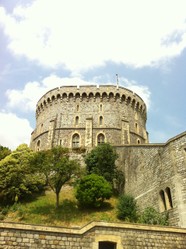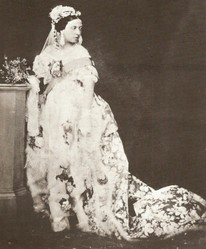Windsor Castle is the oldest inhabited castle in the world. Constructed in 1070 by the Normans it has been developed over the centuries and is now the monarch's weekend residence, though she has dwelt there full time during the covid pandemic, away from the draughty, ill-designed Buckingham Palace. The castle is linked to Windsor Great Park, where Mediaeval monarchs hunted deer for castle feasts, Over the years it is said that twenty five ghosts have been seen, including some regal spectres. Not all can be identified and named. But there is one legendary figure who, tradition says. haunts the park, but not the castle.

The Ghostlore of Windsor Castle
by frankbeswick
A castle over nine hundred and fifty years old has had time to build up some ghostlore.
Windsor
Castle are constructed by people who are having difficulties with the neighbours, and when the neighbours would dearly love to kill you the construction of a defensive edifice becomes urgent. Thus in1070 William the Conqueror constructed Windsor Castle as a defence against rebellious Saxons and he designated a great park to go with it. William brought architects from Europe, who were skilled at castle building, but he used forced labour, Saxons pressed to work for their oppressors. Thus a castle is always an act of violence, a place, where, whatever its subsequent history, people were sad and in pain. Do emotional traces linger in places? Some think so. Or do souls hang on to the places where they dwelt in embodied times?
The castle is a popular place with tourists, and the local people now are generally proud of their local attraction, and while there is a small republican element, like me and my fellow Wizzley writer Veronica, most favour the monarchy. The Great Park is open to the public for recreation, with occasional restrictions for national security. It is a safe place to be, as the police and army are present. Military presence continues during the night, and it can be a lonely and disorientating place to be on duty, especially for rooky soldiers, unused to the way in which night magnifies the significance of noises.
An incident occurred a few years ago, it was not supernatural, but can be attributed to hallucination. An eighteen year old guardsman, one of the elite regiments that are dedicated to defending the monarch, was on night duty. The hours were long, the isolation oppressive, especially for a young lad, and the sounds of the night, animal noises made by foxes and badgers, and the whispering of the winds in the boughs of the great oaks were eerie. Moonlight cast patterns of light and shade, when the frightened teenager said that he saw a statue move. The hallucination can be attributed to the interplay of moonlight and shadow on the mind of a frightened person, and he passed out in terror. When he did not radio his scheduled report a patrol was sent out and found the lad unconscious. He was taken to sick bay and was not punished. The experienced officers know well how the ambience of night in the Great Park plays on the mind.[The army did not release the soldier's name.]
Yet in the nineteenth century a young guardsmen committed suicide when on duty, an act born of depression. A few weeks later Sergeant Leake was on duty at the place where the suicide occurred and was expecting to be relieved when a figure approached. To his horror he found himself face to face with the suicide, who disappeared as the proper replacement came.
Another military incident happened in 1906 when a guard saw a group of men approaching. They ignored his first two challenges, and after the third he fired, only for the bullet to have no effect, causing one of the figures to flinch, but still approach. At that point the soldier charged with his bayonet, only for the figures to disappear. After a search of the grounds proved fruitless, the soldier was punished by being confined to barracks for three nights, which hardly seems fair.
Royalty Hang Around.
Several deceased monarchs are said to drift through the castles ancient halls, though they do not include any of the murderous bunch who succeeded William the conqueror. There are a couple of murderous Tudors. Surprisingly "Bloody" Mary, a misnamed monarch, is not among them. Henry the Eighth has not often been seen, but the sounds of the king, lame in his later years, are said to be audible in Windsor's corridors. Occasionally, Henry is seen in the Deanery corridor, hobbling along. Henry is buried in St George's Chapel in the castle. Readers who have watched royal weddings on television may have seen the place. Henry does not seem to have strayed far from his burial place, well I doubt that he is in heaven! Henry's paramour, Anne Boleyn, is said to be occasionally visible looking tearfully through windows, but she is reputed to haunt several places in England.
Elizabeth the First is said to haunt the library, and there are rumours that the present monarch has seen her. In 1897 Lieutenant Carr Glynn of the Coldstream Guards saw a black-clad woman entering the library and noted her similarity of features to the portrait of the late monarch. Having followed her into the library he asked the librarian who she was, only to be told that no-one had entered prior to him and that there was no other door. The librarian then informed Carr that he had seen the ghost of the Tudor monarch, who seems to haunt the library. She is sometimes preceded by the sound of footsteps. A woman dressed in black is said to be seen peering out through the library windows.
King Charles the First is also said to have been seen, but no stories recount what must have been a fleeting visitation.
King George the Third is not a regular visitor, but there were some manifestations after the death of the monarch who suffered sporadic bouts of insanity and had to be incarcerated while his son ruled as regent. Shortly after the death of the monarch, who reigned for sixty years, an officer leading a troop of soldiers near the room below the library saw the king looking out of the window. He instinctively said "Eyes Right" and so all saw the late king, who waved to them. This was clearly an interactive ghost, unlike those that seem like unresponsive video tapes.
The other twenty or so spirits cannot be identified. Monarchs are more recognisable than commoners, but often have blood on their hands. George the Third was not a violent monarch, as kings go, but he did support slavery and opposed Catholic emancipation, which only happened a few years after his death.
The Phantom Huntsman
Last, but not least, is Herne the Hunter, who is said to lurk in the Great Park and appear when a monarch is about to die and when England is in peril. Herne is unmistakeable, a figure who sports stag's horns, but no one has ever seen him. He is a legendary figure first mentioned in the play, A Winter's Tale, by Shakespeare, who seems to have thought him a fictional character. A version of the Herne story has him roaming the park as a great stag, and it is suggested that mothers used to frighten naughty children with the threat that Herne will get them.
Various explanations for the Herne story are given. Some think him a historical figure turned into a legend, and possible dates are advanced, going back to the time of Richard the Second. The legend is that Herne was a royal huntsman who fell from favour as a result of a malicious campaign of lies by fellow huntsmen jealous of his position. Shamed and broken, Herne hanged himself and as a suicide is doomed to wander the Earth.
Other suggestions are that Herne is a pagan woodland deity, and many pagans, Wiccans especially, follow the pagan anthropologist Margaret Mead, in thinking him a version of the Celtic horned God, Cernunnos, who is represented on the wonderful Gundestrup cauldron, a silver vessel found in Germany. But many scholars object that Cernunnos was not known to have been worshipped in Britain, so Mead's identification of him as the god of the witches is dubious to say the least. However, Herne is sometimes linked to the Wild Hunt, the mythical riding of pagan spirits across the landscape at night. The Wild Hunt is found in many European mythological pantheons, and I think that this idea has some traction. The Saxon god Woden [Odin] was sometimes thought to lead the Wild Hunt, so the legend of Herne may well have blended in some elements of Woden, who also was said to have acquired Wisdom by hanging on a tree for nine days, which fits in well with Herne's hanging himself. Paganism has a plethora of local deities and nature spirits, so Herne could well be one of these, possibly conflated with one or more historical figures.
Without a doubt, Windsor Castle and Great Park are places with a long and significant history, and such places often have an atmosphere. Some people are sensitive to it.
I am an Amazon associate and earn money from qualifying purchases on this page.
You might also like
Thinking about NalediThe new discoveries in the Rising Star cave in South Africa arouse questions ...
The History of the Wedding Dresses: From Beautiful Gowns to Wh...Wedding dresses have changed a lot over the years. The colour is the most not...
The Start of the Gregorian Calendar: The Missing 10 DaysThink the calendar you know has been around forever? Think again! In 1582, th...





 TheThousand Year Gardenon 11/26/2025
TheThousand Year Gardenon 11/26/2025
 Women of the Gospelson 10/11/2025
Women of the Gospelson 10/11/2025
 Religious Gardenson 08/25/2025
Religious Gardenson 08/25/2025
 Doctor of the Church: John Henry Newmanon 08/03/2025
Doctor of the Church: John Henry Newmanon 08/03/2025




Comments
Most people know the main ones,but a few small ones are not well known.
Your comment three boxes below, on Jan. 24, 2024, in answer to my previous observation and question Jan. 23, 2024, intrigues me.
Your answer mentions that "There are quite a few royal residences, as royals do not live with their siblings. I domnot know them all."
Might all or only some royal residences be known to British Isles-ers?
Few royal workers dwell in the palaces. The late queen had a friend who had rooms in Balmoral.
Thank you for your comment below on Jan. 24, 2024, in answer to my previous-day observation and question.
Royal residences all must have designated family, personal, private areas and office, professional areas, correct? They must not mix the private and the professional even as the latter undoubtedly mandates employees, correct?
Would employees in the royal residences be distant or not-so-distant relatives or would they never be related to the royal residents?
There are quite a few royal residences, as royals do not live with their siblings. I domnot know them all.
Thank you!
How many royal residences are there?
Do they tend to be more defendable, like Windsor Castle, or more exposed, like Buckingham Palace?
The defensive walls were around the castle, as a wall around the park would be too long to be practical to defend.
The first paragraph to the first subheading, Windsor, considers that "Thus in1070 William the Conqueror constructed Windsor Castle as a defence against rebellious Saxons and he designated a great park to go with it."
Did the park have some kind of defensive walls or was it left open?
Either way, was nature, such as forests, or were structures, such as guardhouses or huts, along park borders?
You would have to ask Veronica about that, but the stone tape theory predates that drama by some time.
Would Veronica's suggestion about your writing a Stone Tape-related article be referring to the film that Wikipedia describes as "British television horror drama film" and defers to drama, psychological thriller, science fiction and supernatural horror categories?